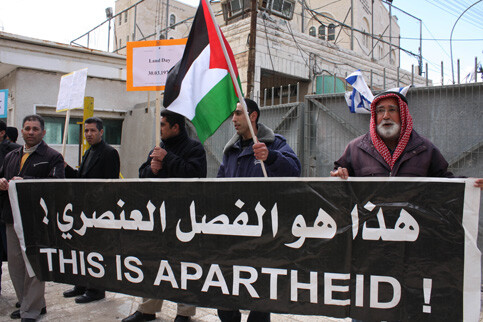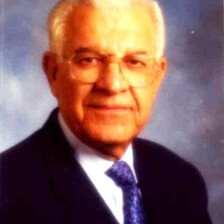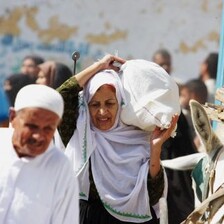The Electronic Intifada 3 April 2009

Palestinians in the occupied West Bank city of Hebron demonstrate against Israeli “apartheid,” 30 March 2009. (Mamoun Wazwaz/MaanImages)
In recent years, increasing numbers of individuals around the world have begun adopting and developing an analysis of Israel as an apartheid regime. This can be seen in the ways that the global movement in support of the Palestinian anti-colonial struggle is taking on a pointedly anti-apartheid character, as evidenced by the growth of Israeli Apartheid Week ( http://apartheidweek.org/). Further, much of the recent international diplomatic support for Israel has increasingly taken on the form of denying that racial discrimination is a root cause of the oppression of Palestinians. This has taken on new levels of absurdity in Western responses to the April 2009 Durban Review Conference, a follow-up to the 2001 World Conference Against Racism held in Durban, South Africa in which Palestinians were identified as victims of racism (the US, Israel, Canada and Italy have already announced that they will not participate because of the potential for criticism of Israel).
Many of the writings stemming from this analysis work to detail levels of similarity and difference with apartheid South Africa, rather than looking at apartheid as a system that can be practiced by any state. To some extent, this strong emphasis on historical comparisons is understandable given that boycott, divestment and sanctions is the central campaign called for by Palestinian civil society for solidarity with the Palestinian liberation struggle, and is modeled on the one that helped end South African apartheid. However, an over-emphasis on similarities and differences confines the use of the term to narrow limits. With the expanding agreement that the term “apartheid” is useful in describing the level and layout of Israel’s crimes, it is important that our understanding of the “apartheid label” be deepened, both as a means of informing activism in support of the Palestinian anti-colonial struggle, and in order to most effectively make use of comparisons with other struggles.
The apartheid analogy
It is perhaps understandable that some advocates of Palestinian rights look at the “apartheid label,” in its comparative sense, as a politically useful tool. The struggle of the South African people for justice and equality reached a certain sacred status in the 1980s and ’90s when the anti-apartheid struggle reached its zenith. The reverence with which activists and non-activists alike look to the righteousness of the South African struggle, and the ignominy of the colonial apartheid regime, are well placed. Black South Africans fought against both Dutch and British colonization for centuries, endured countless hardships including imprisonment and death, and were labeled terrorists as the powers of the world stood by the racist apartheid regime. They remained steadfast in their struggle, raising the cost of maintaining the apartheid system until South African capital found it no longer profitable and white political elites found it impossible to maintain. The comparison is further enhanced due to the relationship between the respective Palestinian and South African liberation movements, the Palestine Liberation Organization and the African National Congress, as well as the unabashed alliance between Israel and the South African apartheid regime, which remained strong even at the height of the international boycott against South Africa.
A further impetus for confining the “apartheid label” to a comparison with South Africa is that the commonalities and similarities between the liberation struggles of South Africa and Palestine are quite stark. Both cases involved a process of settler-colonialism involving the forced displacement of the indigenous population from most of their ancestral lands and concentrating them in townships and reservations, dividing the colonized community into different groups with differing rights, strict mobility restrictions that suffocated the colonized, and the use of brutal military force to repress any actual or potential resistance against the racist colonial regime.
Both regimes have enjoyed the impunity that results from full US and European support. Accompanying these and countless other similarities are a host of uncanny details common to both cases: both regimes were formally established in the same year — 1948 — following decades of British rule; approximately 87 percent of the land was off limits to most of the colonized population without special permission, and so on. While we speak here in the past tense for South Africa, this still applies to present-day Palestine.
As the Israeli apartheid label has gained ground, some have adopted the approach of describing the differences between the two regimes, albeit for various purposes. In general, Israel has not legislated petty apartheid — the segregation of spaces such as bathrooms and beaches — as was the case in South Africa. However, Israeli laws form the basis of systematic racial discrimination against Palestinians. The 1.2 million Palestinian citizens of Israel (approximately 20 percent of Israel’s citizens) do indeed have the right to vote and run in Israeli elections while the Black community in South Africa, for the most part, did not. The South African version of apartheid’s central tenet was to facilitate the exploitation of as many Black laborers as possible, whereas the Israeli version, although exploiting Palestinian workers, prioritizes the forced displacement of as many Palestinians as possible beyond the borders of the state with the aim of eradicating Palestinian presence within historic Palestine. South African visitors to Palestine have often commented on the fact that Israeli use of force is more brutal than that witnessed in the heyday of apartheid, thus leading several commentators to adopt the position that Israel’s practices are worse than apartheid and that the apartheid label does not go far enough.
Israel and the crime of apartheid
In terms of law, describing Israel as an apartheid state does not revolve around levels of difference and similarity with the policies and practices of the South African apartheid regime, and where Israel is an apartheid state only insofar as similarities outweigh differences. In 1973, the UN General Assembly adopted the International Convention on the Suppression and Punishment of the Crime of Apartheid (General Assembly resolution 3068 entered into force on 18 July 1976 — the year of the Soweto uprising in South Africa and the Land Day uprising in Palestine). The resolution set forth that the definition of the crime of apartheid was not limited to the borders of South Africa. The fact that apartheid is defined as a crime under the Rome Statute of the International Criminal Court, which entered into force in 2002 — long after the apartheid regime was defeated in South Africa — attests to the universality of the crime.
While the wording of the definition of the crime of apartheid varies between legal instruments, the substance is the same: a regime commits apartheid when it institutionalizes discrimination to create and maintain the domination of one “racial” group over another. Karine Mac Allister, among others, has provided a cogent legal analysis of the applicability of the crime of apartheid to the Israeli regime (see “Applicability of the Crime of Apartheid to Israel,” al-Majdal #38, Summer 2008). The main point is that like genocide and slavery, apartheid is a crime that any state can commit, and institutions, organizations and/or individuals acting on behalf of the state that commit it or support its commission are to face trial in any state that is a signatory to the Convention, or in the International Criminal Court. It is therefore a fallacy to ground the Israeli apartheid label on comparisons of the policies of the South African apartheid regime, with the resulting descriptions of Israel as being “apartheid-like” and characterizations of an apartheid analysis of Israel as an “apartheid analogy.”
Recognition by the international community of such universal crimes is often the result of a particular case, so heinous that it forces the rusty wheels of international decision-making into motion. The Transatlantic Slave Trade is an example where the mass enslavement of peoples from the African continent to work as the privately owned property of European settlers formed an important part of the framework in which the drafters of the 1956 UN Supplementary Convention on the Abolition of Slavery thought and acted. An even clearer example is the Genocide Convention (adopted in 1948, entered into force in 1951) in the wake of the Nazi Holocaust in which millions of Jews, communists, Roma and disabled were systematically murdered with the intention to end their existence. We do not describe modern day enslavement as “slavery-like,” nor do we examine the mass killing of hundreds of thousands of mainly Tutsi Rwandans through a Rwandan “genocide analogy.”
Two points made by Mac Allister in her legal analysis of Israeli apartheid deserve to be reiterated because they are often confused or misconstrued even by advocates of Palestinian human rights. First, Israel’s crimes and violations are not limited to the crime of apartheid. Rather, Israel’s regime over the Palestinian people combines apartheid, military occupation and colonization in a unique manner. It deserves notice that the relationship between these three components requires further research and investigation. Also noteworthy is the Palestinian Boycott, Divestment and Sanctions Campaign National Committee’s “United Against Apartheid, Colonialism and Occupation: Dignity & Justice for the Palestinian People” position paper, which outlines and, to some extent, details the various aspects of Israel’s commission of the crime of apartheid, and begins to trace the interaction between Israeli apartheid, colonialism and occupation from the perspective of Palestinian civil society. [1]
The second point worth reiterating is that Israel’s regime of apartheid is not limited to the West Bank and Gaza Strip. In fact, the core of Israel’s apartheid regime is guided by discriminatory legislation in the fields of nationality, citizenship and land ownership. This discriminatory legislation was primarily employed to oppress and dispossess those Palestinians (refugees and internally displaced) who were forced from their land and property during the 1948 Nakba, or catastrophe, as well as the minority who managed to remain within the 1949 armistice line (referred to as the “green line”), who later became Israeli citizens. Israel’s apartheid regime was extended into the West Bank and Gaza Strip following the 1967 occupation of those territories for the purpose of colonization and military control over the Palestinians who came under occupation. Using again the example of South Africa, the crime of apartheid was not limited to the Bantustans — the whole regime was implicated and not one or another of its racist manifestations.
The analysis of Israel as an apartheid state has proven to be very important in several respects. First, it correctly highlights racial discrimination as a root cause of Israel’s oppression of Palestinians. Second, one of the main effects of Israeli apartheid is that it has separated Palestinians — conceptually, legally and physically — into different groupings (refugees, West Bank, Gaza, within the “green line” and a host of other divisions within each), resulting in the fragmentation of the Palestinian liberation movement, including the solidarity movement. The apartheid analysis enables us to provide a legal and conceptual framework under which we can understand, convey and take action in support of the Palestinian people and their struggle as a unified whole. Third, and of particular significance to the solidarity movement, this legal and conceptual framework takes on the prescriptive role underpinning the growing global movement for boycott, divestment and sanctions against Israel until it complies with international law.
Colonialism and the role of comparison
I have argued that the question of whether apartheid applies cannot be determined by means of comparison with South Africa, but rather by legal analysis. This, however, does not mean that comparative study is not useful. Comparison is in fact essential to the process of learning historical lessons for those involved in struggle. A central point of comparison with South Africa is the fact that it was, and for the indigenous people of Palestine and the Americas, continues to be a struggle against colonialism.
Focusing on the colonial dimension of Israeli apartheid and the Zionist project enables us to maintain our focus on the issues that really matter, such as land acquisition, demographic engineering and methods of political and economic control exercised by one racial group over another. Comparison with other anti-colonial struggles provides the main resource for understanding this colonial dimension of Israeli oppression, and for deriving some of the lessons needed to fight it.
One of the key lessons for Palestinians from the struggle against apartheid in South Africa was the pressure placed on the African National Congress leadership to compromise on its economic demands such as land restitution. Only a tiny proportion of white-controlled land in South Africa was redistributed to Blacks after 1994. As such, while the struggle of the South African people defeated the system of political apartheid, the struggle against economic apartheid continues in various forms including anti-poverty and landless peoples’ movements today. The centrality of the demand for land restitution should be highlighted as part of the demand for refugee return as Palestinians and those struggling with them work to reconstruct a political strategy and consensus on how to overcome the political challenges that have emerged since the launching of the peace process and the transformation of the Palestinian liberation movement leadership into a non-sovereign authority dependent on Israel for its international legitimacy and financial solvency.
A second key lesson is in response to the paradigm currently guiding most mainstream accounts of how to achieve the elusive “peace in the Middle East,” which is the idea of partition often referred to as the “two-state solution.” In the 1970s, South Africa tried to deal with its “demographic problem” — the fact that the vast majority of its population was Black but did not have the right to vote. The apartheid regime reconstructed South Africa as a formal democracy by reinventing the British-established reservations (the Bantustans) as independent states (British rule in South Africa established reserves in 1913 and 1936 on approximately 87 percent of the land of South Africa for the purpose of segregating the Black population from the settlers). These 10 “homelands” were each assigned to an ethnicity decided by Pretoria, and indigenous South Africans who did not fit into one of the ethnicities were forced to make themselves fit in order to become nationals of one of the homelands. Through this measure, members of the indigenous population were reclassified as nationals of a homeland, and between 1976 and 1981 the regime tried to pass the homelands off as independent states: Transkei in 1976, Bophuthatswana in 1977, Venda in 1979, and Ciskei in 1981.
Each of these Bantustans was given a flag and a government made up of indigenous intermediaries on the Pretoria payroll, and all the trappings of a sovereign government including responsibility over municipal services and a police force to protect the apartheid regime, but without actual sovereignty. The idea was that by getting international recognition for each of these homelands as states, the apartheid regime would transform South Africa from a country with a 10 percent white minority, to one with a 100 percent white majority. Since it was a democratic regime within the confines of the dominant community, the state’s democratic nature would be beyond reproach. No one was fooled. The African National Congress launched a powerful campaign to counter any international recognition of the Bantustans as independent states, and the plot failed miserably at the international level — with the notable, but perhaps unsurprising, exception that a lone “embassy” for Bophuthatswana was opened in Tel Aviv.
Israel has employed similar strategies in Palestine. For example, Israel recognized 18 Palestinian Bedouin tribes and appointed a loyal sheikh for each in the Naqab (Negev) desert during the 1950s as a means of controlling these southern Palestinians, forcing those who did not belong to one of the tribes to affiliate to one in order to get Israeli citizenship (see Hazem Jamjoum, “al-Naqab: The Ongoing Displacement of Palestine’s Southern Bedouin,” al-Majdal #39-40, Autumn 2008/Winter 2009). In the late 1970s, the Israeli regime tried to invent Palestinian governing bodies for the West Bank and Gaza Strip in the form of “village leagues” intended to evolve into similar non-sovereign governments — glorified municipalities of a sort. As with apartheid’s Homelands, the scheme failed miserably, both because the Palestine Liberation Organization (PLO) had established itself as the sole legitimate representative of the Palestinian people, and because Palestinians largely understood the plot and opposed it with all means at their disposal. The main lesson for Israel was that the PLO would have to either be completely destroyed or would have to be transformed into Israeli apartheid’s indigenous intermediary. Israel launched a massive campaign to destroy the PLO throughout the 1980s and early ’90s. With the demise of the PLO’s main backers in the Soviet bloc at the end of the Cold War and its strained relations with Saudi Arabia and Kuwait after the first Gulf War, Israel capitalized on the opportunity, and worked to transform the PLO from a liberation movement to a “state-building” project that was launched by the signing of the Oslo Accords, seven months before South Africa’s first free election.
The push for the establishment and international recognition of an independent Palestinian state within the Palestinian Bantustan is no different from the South African apartheid regime’s campaign to gain international recognition of Transkei or Ciskei. This is the core of the “two-state solution” idea. The major and crucial difference is that in the current Palestinian case, it is the world’s superpower and its adjutants in Europe and the Arab world pushing as well, and armed with the active acceptance of Palestine’s indigenous intermediaries.
Hazem Jamjoum is the editor of al-Majdal, the English language quarterly magazine of the Badil Resource Center for Palestinian Residency and Refugee Rights in Bethlehem, Palestine.
Endnotes
[1] This is the Palestinian civil society position paper for the April 2009 Durban Review Conference in Geneva, and can be downloaded at: http://bdsmovement.net/files/English-BNC_Position_Paper-Durban_Review.pdf (accessed 29 March 2009).
Related Links




